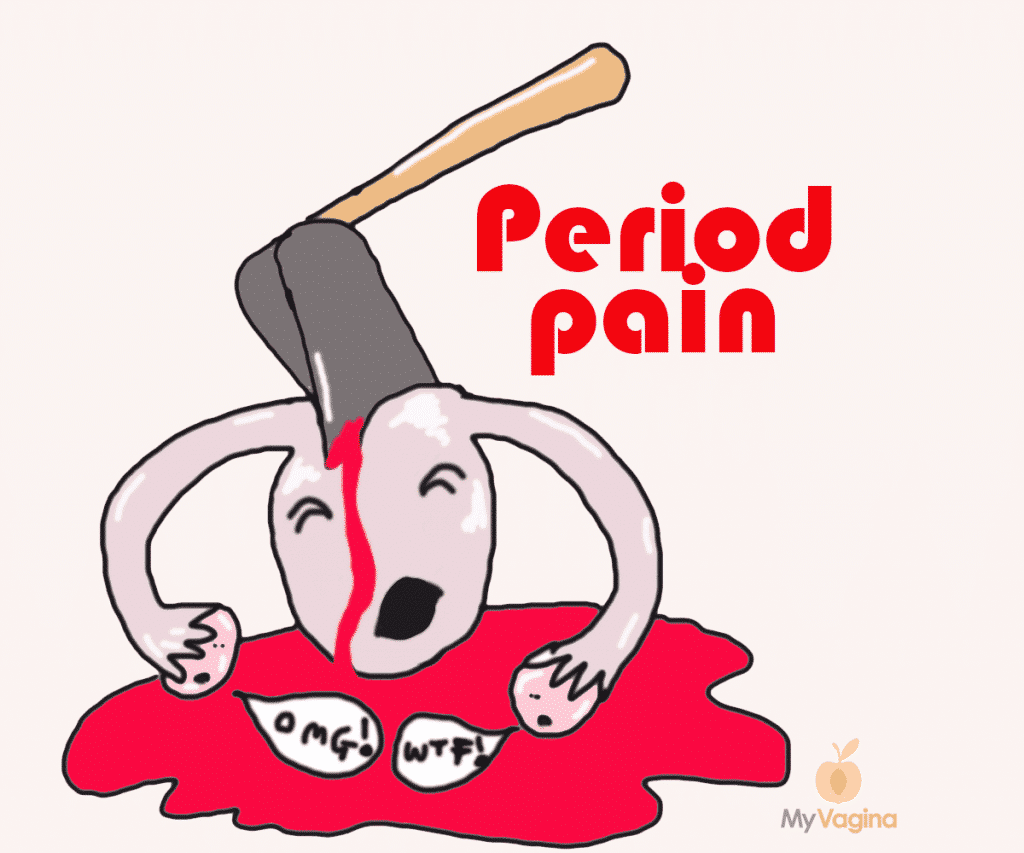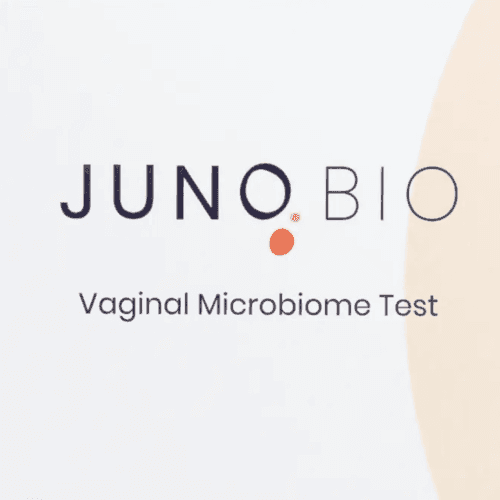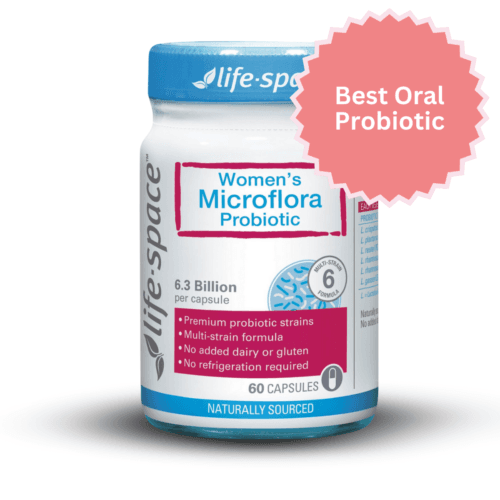Period pain is caused by the process of the uterus expelling menstrual blood, with the medical name for period pain being dysmenorrhoea.
Period pain can be related to the physical cramping of your uterus, nerve pain caused by inflammation of your uterus and surrounding tissues or a medical condition like endometriosis.
Period pain can be debilitating and taxing on the soul, with painful periods being a huge contributor to skipping work or school1–5 to curl up into a ball and moan, sucking back pain killers to get us through.
Imagine, just for once, forgetting that you have your period
If you have period pain that is debilitating, you need to be checked over by your doctor to make sure there isn’t something else wrong.
Once you have a diagnosis of primary dysmenorrhoea6,7 (just regular ‘run-of-the-mill’ period pain), you can move on to figuring out the best treatment for you. Or, work on the larger cause.
If you have severe period pain, this is not normal and requires investigation.
Causes of period pain (primary8,9 and secondary dysmenorrhoea)8
It’s important to understand the differences between the types of period pain you may be experiencing. If your period pain has just appeared after having no period pain or low-moderate levels of pain previously, you may an underlying health condition that is causing worse pain.
This sort of pain needs to be checked out by a doctor, as you could have a greater problem than just painful periods. We’ve split period pain into two categories: primary and secondary.
Primary dysmenorrhoea9 means you’ve always had this type of period pain or some version of, and secondary means your pain is caused by an underlying health condition, meaning something has changed.
Symptoms of period pain10
- Dull and heavy pain and sensation (congestive period pain) in the uterus and abdomen
- Spasms of the uterus – comes and goes, may be excrutiating
- Be accompanied by headaches, vomiting, nausea, diarrhoea, constipation or blood clots
- Bowel is affected by hormone changes and muscle contractions of the uterus, can be affected in unusual ways, diarrhoea, constipation
- Back ache, leg ache, labial pains, radiating pains
- Pain starts just before or after the blood starts to flow
- Lower back pain that radiates to the labia, back and/or thighs
- Upon examination, everything may look normal
- Usually occurs during teenage years, at or near the first year of periods (primary dysmenorrhoea)
- Can get worse with age, or come on suddenly later in life (secondary dysmenorrhoea)
Checklist of symptoms that may indicate you have an underlying health condition (secondary dysmenorrhoea)
- Periods start to get more painful as you get older
- Periods suddenly start being painful
- Pain develops where there was none or only minor pain before
- Period pain might be accompanied by suddenly heavier or irregular periods
- Pain could be during the first or second periods of a girl’s life, indicating a blockage of some kind
- A pelvic examination may find something unusual
- Usually oral contraceptives and non-steroidal anti-inflammatory drugs (NSAIDs) don’t help these types of pain
- Infertility, painful sex (dyspareunia) and vaginal discharge may be present
- This form of period pain is most likely to be diagnosed between the ages of 30 and 45
- Increased prostaglandins may play a role in secondary dysmenorrhoea too, but there must be another condition going on at the same time for it to be classified thus
Secondary dysmenorrhoea may be caused by:
- Endometriosis
- Pelvic inflammatory disease (PID)
- Adenomyosis
- Fibroids
- Uterine polyps
- Ovarian cysts
- Ovarian tumours
- Cervical stenosis or blockage
- Intrauterine adhesions
- Allen-Masters syndrome
- Pelvic congestion syndrome
- Transverse vaginal septum
- Intra-uterine devices (IUDs)
- Anatomical abnormalities
- Psychogenic pain (aggravated by stress)
Understanding and diagnosing period pain8
There is no one specific test for period pain, except to rule out any underlying conditions as per symptoms. Your practitioner may take blood tests, do scans, and other tests to exclude a more serious health condition causing your period pain.
Taking period pain seriously
Period pain is a pain condition in its own right, so if you are experiencing period pain, remember that your pain is to be taken seriously. It’s not just something you have to tolerate because you have a uterus.
Ask for help when you need it and expect to be treated by your healthcare practitioner in a meaningful way.
Remember: period pain can be treated, managed, and heavily reduced to make it bearable or disappear! You do not have to put up with period pain. It is NOT your cross to bear11.
Why you have regular period pain – mostly, blame prostaglandins
It is easy to say, period pain is your uterus cramping, which is true, but there is more to it than that. The cramping is your body’s way of expelling your menstrual blood, which needs to happen (maybe not so aggressively).
Your uterus is a muscle, however, so like any muscle, when you start using it, it can be extremely painful as it gets used to the ‘exercise’. But, period pain comes with its own special horrors.
A special compound (prostaglandin – PGF2α) causes the centre layer of your uterine muscle to contract strongly. This can cause immense pain. One of the issues with the prostaglandin effect is that this long, slow, contraction of your uterus blocks blood flow.
A lack of blood flow causes a lack of oxygen in the middle muscle layer of your uterus. This lack of oxygen can cause severe pain. Muscles need oxygen and without them, they hurt like crazy. How much pain you have is directly correlated to how much prostaglandin is in your blood. These prostaglandins start to increase between periods (about in the middle).
If you are not on hormonal birth control, this is around the time you would normally ovulate. At your period, these prostaglandins get bumped up a level or two, causing uterine contractions and sometimes this extreme pain.
Period pain like this is most likely to be diagnosed or experienced in your teenage years. Researchers are still not 100 per cent sure why it happens, but what we know so far is that period pain is the result of a combination of events triggered by hormones, chemical mediators, body temperature, sleep patterns, and the nervous system.
Luckily, there are many things you can do to
- A) increase oxygen flow to your uterus during your period
- B) block prostaglandins from exerting their terrible effect and
- C) improving the function of your uterine muscle so it relaxes a bit.
Once your uterus relaxes, the inflammation that your raging womb normally creates subsides. The related causes of period pain, like a sore back, ease off.
Prostaglandins cannot alter ‘period headaches’, and may not be useful in augmenting other problematic symptoms like nausea.
Treating period pain by dealing with prostaglandins8
Painkillers to block prostaglandins
Period pain can be interrupted using anti-inflammatory painkillers (drugs) that block the action of prostaglandin. The most effective prostaglandin-blocking drugs include ibuprofen and aspirin, but each of you will respond best to one or another. Try out a few and see which you should keep in your backpack just in case.
Painkillers that block prostaglandins (anti-inflammatories) work very well for most people, and because periods tend to get less painful as we get older, the need for pain medication should reduce over time. Can put strain on the liver processing medication.
Lifestyle modifications to reduce period pain – FREE!
Many people find that a few additions/subtractions from their normal lives can reduce period pain. These mods include exercise12 and quitting smoking.
Exercise releases natural painkillers and increases oxygen flow. Smoking, on the other hand, decreases oxygen flow around your body, which can add to the problems.
Fish oils13 and vitamin B12 to block prostaglandins
Fish oils are known to block the action of prostaglandins and can be used over a period of time in therapeutic doses to alleviate period pain.
A thousand milligrams of fish oil every day for one cycle was found to be more effective than ibuprofen in managing period pain in one study (see References).
The fish oil should be taken every day. The more severe the period pain, the higher the dose of fish oil should be.
High quality fish oil has more of the beneficial elements, so don’t skimp on price when you’re buying fish oil. Price reflects quality processing and product, but look up a company’s processing methods. Avoid chemical extraction of fish oils.
- Omega-3 fatty acids (high dose fish oil, 2.5g per day with total EPA of about 1,000mg and DHA 700mg – this is high, therapeutic doses, check label for EPA and DHA quantities)
- Vitamin B12 combined with fish oil works even better (7.5mcg per day).
Self-massage your uterus (from the outside!) – FREE!
Massaging your uterus firmly while lying down relaxed can reduce or remove the uterine spasms by improving blood supply – and oxygen – to the uterine muscle.
Lie down on a comfortable surface and push gently but firmly around your uterine area through your abdomen, until you feel the muscle start to relax.
Give yourself at least 20 minutes to really massage your uterus. If you give this massage the right amount of time, you can make a big difference in your day – for free.
You’ll notice your period pain reduces or disappears, at least for a while, for most women. Repeat as necessary.
Diet adjustments to reduce prostaglandins and reduce period pain
- Reduce intake of saturated fats
- Eat more vegetarian and vegan meals
- Eat low fat foods (but avoid ‘diet’ foods)
Going on the pill
The oral contraceptive pill is also used to change your periods and reduce period pain by modifying your natural cycle. When you are on the pill, your natural cycle is a thing of the past, and you are running on synthetic hormones that prevent the prostaglandin cascade, along with everything else.
Your periods on the pill are not real periods, but called withdrawal bleeds. This is different to a real period in some key ways, including the prostaglandin release and ovulation. Interrupts fertility, microflora and hormones.
Using herbs for easier periods – uterine tonics to relax the uterus, herbal pain relievers, prostaglandin-blockers, hormone modifiers
Treating period pain with herbal medicine and some key supplements can be effective for many women, but having the right herbs and supplements for your body is important.
A uterine tonic may help to regulate and normalise the uterus, plus some relaxing, pain-relieving or prostaglandin-blocking herbs to reduce pain.
Hormone-regulating herbs may be used to help normalise hormones. Herbs may be taken all month, not just at your period, or for part of your cycle.
We recommend seeing a qualified, experienced herbalist or naturopath to get a prescription that suits your body. You can figure out how to use herbs at home, but be safe. Just because herbs are natural, does not mean they are safe for everyone all the time.
Herbs are potent, powerful medicine and should be treated with the respect and cautions we offer other types of medicine.
Uterine tonic herbs
- Aletris farinosa
- Caulophyllum thalictroides
- Angelica sinensis
- Rubus idaeus
- Combine generally with Vitex agnus-castus or Paeonia lactiflora as indicated
Hormone-regulating herbs
- Vitex agnus-castus
- Paeonia lactiflora
- Paeonia suffruticosa
- Actaea racemosa
- Verbena officinalis
Antispasmodic herbs (for crampy pain, vomiting, diarrhoea)
- Viburnum opulus
- Viburnum prunifolium
- Caulophyllum thalictroides
- Dioscorea villosa
- Ligusticum wallichii
- Paeonia lactiflora
- Glycyrrhiza glabra
Warming herbs (works well mixed with anti-spasmodics)
- Zingiber officinale
- Cinnamomum zeylenicum
Relaxing herbs
- Valeriana officinalis
- Piscidia erythrina
- Corydalis ambigua
- Verbena officinalis
- Matricaria recutita
- Paeonia lactiflora
Pain-relieving herbs
- Corydalis ambigua
- Piscidia erythrina
- Lactuca vrisa
- Anemone pulsatilla
- Zingiber officinale
- Tanacetum parthenium
- Curcuma longa
Other treatments that can help naturally reduce period pain
- Acupuncture14–19
- Reflexology20–24
- Relaxation techniques25–27
- Aromatherapy28–33
- Heat packs/hot water bottles26
- Sex34–36 (orgasm can help relieve pelvic congestion, though that might be the last thing you feel like)
References37–39
- 1.Mesele TT, Ayalew HG, Syoum AT, Antehneh TA. Impact of Dysmenorrhea on Academic Performance Among Haramaya University Undergraduate Regular Students, Eastern Ethiopia. Front Reprod Health. Published online July 6, 2022. doi:10.3389/frph.2022.939035
- 2.Mizuta R, Maeda N, Tashiro T, et al. Quality of life by dysmenorrhea severity in young and adult Japanese females: A web-based cross-sectional study. Aimagambetova G, ed. PLoS ONE. Published online March 16, 2023:e0283130. doi:10.1371/journal.pone.0283130
- 3.Armour M, Parry K, Manohar N, et al. The Prevalence and Academic Impact of Dysmenorrhea in 21,573 Young Women: A Systematic Review and Meta-Analysis. Journal of Women’s Health. Published online August 2019:1161-1171. doi:10.1089/jwh.2018.7615
- 4.Al-Matouq S, Al-Mutairi H, Al-Mutairi O, et al. Dysmenorrhea among high-school students and its associated factors in Kuwait. BMC Pediatr. Published online March 18, 2019. doi:10.1186/s12887-019-1442-6
- 5.Joshi T, Kural M, Noor N, Pandit D, Patil A. Menstrual characteristics and prevalence of dysmenorrhea in college going girls. J Family Med Prim Care. Published online 2015:426. doi:10.4103/2249-4863.161345
- 6.Zhu X, Bensoussan A, Zhu L, et al. Primary dysmenorrhoea: A comparative study on Australian and Chinese women. Complementary Therapies in Medicine. Published online June 2009:155-160. doi:10.1016/j.ctim.2008.10.001
- 7.Aouad P, Bui M, Sarraf S, et al. Primary dysmenorrhoea in adolescents and young women: A twin family study of maternal transmission, genetic influence and associations. Aust NZ J Obst Gynaeco. Published online June 27, 2022:725-731. doi:10.1111/ajo.13560
- 8.Itani R, Soubra L, Karout S, Rahme D, Karout L, Khojah HMJ. Primary Dysmenorrhea: Pathophysiology, Diagnosis, and Treatment Updates. Korean J Fam Med. Published online March 20, 2022:101-108. doi:10.4082/kjfm.21.0103
- 9.Iacovides S, Avidon I, Baker FC. What we know about primary dysmenorrhea today: a critical review. Hum Reprod Update. Published online September 7, 2015:762-778. doi:10.1093/humupd/dmv039
- 10.Chen CX, Draucker CB, Carpenter JS. What women say about their dysmenorrhea: a qualitative thematic analysis. BMC Women’s Health. Published online March 2, 2018. doi:10.1186/s12905-018-0538-8
- 11.Tataj-Puzyna U, Ilczuk P, Kalita-Kurzyńska K, Gotlib J. Women’s experiences of dysmenorrhoea – preliminary study. pm. Published online 2021:133-139. doi:10.5114/pm.2021.109771
- 12.Armour M, Ee CC, Naidoo D, et al. Exercise for dysmenorrhoea. Cochrane Database of Systematic Reviews. Published online September 20, 2019. doi:10.1002/14651858.cd004142.pub4
- 13.Zafari M, Behmanesh F, Agha M. Comparison of the effect of fish oil and ibuprofen on treatment of severe pain in primary dysmenorrhea. Caspian J Intern Med. 2011;2(3):279-282. https://www.ncbi.nlm.nih.gov/pubmed/24049587
- 14.Yu WY, Ma LX, Zhang Z, et al. Acupuncture for Primary Dysmenorrhea: A Potential Mechanism from an Anti-Inflammatory Perspective. Lu L, ed. Evidence-Based Complementary and Alternative Medicine. Published online December 3, 2021:1-12. doi:10.1155/2021/1907009
- 15.Zhang F, Sun M, Han S, et al. Acupuncture for Primary Dysmenorrhea: An Overview of Systematic Reviews. Evidence-Based Complementary and Alternative Medicine. Published online November 21, 2018:1-11. doi:10.1155/2018/8791538
- 16.Smith CA, Armour M, Zhu X, Li X, Lu ZY, Song J. Acupuncture for dysmenorrhoea. Cochrane Database of Systematic Reviews. Published online April 18, 2016. doi:10.1002/14651858.cd007854.pub3
- 17.Smith CA, Crowther CA, Petrucco O, Beilby J, Dent H. Acupuncture to Treat Primary Dysmenorrhea in Women: A Randomized Controlled Trial. Evidence-Based Complementary and Alternative Medicine. Published online 2011:1-11. doi:10.1093/ecam/nep239
- 18.Wang Y, Xu J, Zhang Q, et al. Immediate Analgesic Effect of Acupuncture in Patients With Primary Dysmenorrhea: A fMRI Study. Front Neurosci. Published online May 24, 2021. doi:10.3389/fnins.2021.647667
- 19.Woo HL, Ji HR, Pak YK, et al. The efficacy and safety of acupuncture in women with primary dysmenorrhea. Medicine. Published online June 2018:e11007. doi:10.1097/md.0000000000011007
- 20.Valiani M, Babaei E, Heshmat R, Zare Z. Comparing the effects of reflexology methods and Ibuprofen administration on dysmenorrhea in female students of Isfahan University of Medical Sciences. Iran J Nurs Midwifery Res. 2010;15(Suppl 1):371-378. https://www.ncbi.nlm.nih.gov/pubmed/22069413
- 21.Akbarzadeh M, Behbahani B, Ansaripour L, Zare N, Hadianfard M. Comparison of the effects of acupressure and self-care behaviors training on the intensity of primary dysmenorrhea based on McGill pain questionnaire among Shiraz University students. J Res Med Sci. Published online 2016:104. doi:10.4103/1735-1995.193176
- 22.ALP YILMAZ F, BAŞER M. Effects of foot reflexology on dysmenorrhea: a randomized controlled trial. Cukurova Medical Journal. Published online December 29, 2019:54-60. doi:10.17826/cumj.550663
- 23.ŞOLT A, DOLGUN G. The Effect of Acupressure on Menstrual Pain. International Journal of Traditional and Complementary Medicine Research. Published online August 5, 2022:71-81. doi:10.53811/ijtcmr.1052531
- 24.Mirbagher-Ajorpaz N, Adib-Hajbaghery M, Mosaebi F. The effects of acupressure on primary dysmenorrhea: A randomized controlled trial. Complementary Therapies in Clinical Practice. Published online February 2011:33-36. doi:10.1016/j.ctcp.2010.06.005
- 25.Çelik AS, Apay SE. Effect of progressive relaxation exercises on primary dysmenorrhea in Turkish students: A randomized prospective controlled trial. Complementary Therapies in Clinical Practice. Published online February 2021:101280. doi:10.1016/j.ctcp.2020.101280
- 26.Agustin Y, Afrina R, Rukiah N. Giving Warm Compresses with Progressive Muscle Relaxation Techniques Can Reduce Pain Intensity in Dysmenorrhea. JCN. Published online October 1, 2022:99-105. doi:10.53801/jcn.v1i3.51
- 27.Yildiz E, Acaroğlu R. The Effect of Massage and Progressive Relaxation Exercises on Pain Intensity and Menstrual Symptoms in Students With Primary Dysmenorrhea. Holistic Nursing Practice. Published online September 2022:284-294. doi:10.1097/hnp.0000000000000541
- 28.Lee M, Lee H, Khalil M, Lim H, Lim HJ. Aromatherapy for Managing Pain in Primary Dysmenorrhea: A Systematic Review of Randomized Placebo-Controlled Trials. JCM. Published online November 10, 2018:434. doi:10.3390/jcm7110434
- 29.Han SH, Hur MH, Buckle J, Choi J, Lee MS. Effect of Aromatherapy on Symptoms of Dysmenorrhea in College Students: A Randomized Placebo-Controlled Clinical Trial. The Journal of Alternative and Complementary Medicine. Published online July 2006:535-541. doi:10.1089/acm.2006.12.535
- 30.Song JA, Lee M kyoung, Min E, Kim ME, Fike G, Hur MH. Effects of aromatherapy on dysmenorrhea: A systematic review and meta-analysis. International Journal of Nursing Studies. Published online August 2018:1-11. doi:10.1016/j.ijnurstu.2018.01.016
- 31.Marzouk TMF, El-Nemer AMR, Baraka HN. The Effect of Aromatherapy Abdominal Massage on Alleviating Menstrual Pain in Nursing Students: A Prospective Randomized Cross-Over Study. Evidence-Based Complementary and Alternative Medicine. Published online 2013:1-6. doi:10.1155/2013/742421
- 32.Najaf Najafi M, Najaf Najafi N, Rashidi Fakari F, et al. The Effect of Aromatherapy Alone or in Combination with Massage on Dysmenorrhea: A Systematic Review and Meta-analysis. Rev Bras Ginecol Obstet. Published online December 2021:968-979. doi:10.1055/s-0041-1740210
- 33.Ristiani, Arsyad A, Usman AN, Syamsuddin S, Ahmad M, Sinrang AW. The use of aromatherapy in primary dysmenorrhea. Gaceta Sanitaria. Published online 2021:S591-S595. doi:10.1016/j.gaceta.2021.10.090
- 34.Mollazadeh S, Sadeghzadeh Oskouei B, Kamalifard M, Mirghafourvand M, Aminisani N, Shobeiri MJ. Association between Sexual Activity during Menstruation and Endometriosis: A Case-Control Study. Int J fertil Steril. Published online October 2019. doi:10.22074/ijfs.2019.5601
- 35.Finžgar M, Dahmane Gošnak R, Poljšak B, Starc A. The Effect of Lifestyle on Primary Dysmenorrhea. J appl health sci (Online). Published online February 3, 2022:47-55. doi:10.24141/1/8/1/5
- 36.Mathur CN, Jain P, Lall SB. Psychometric Studies on the Possible Relationship between sexual orgasm and primary Original Dysmennorrhea in Indian Women. Indian Journal of Psychological Medicine. Published online January 1988:17-20. doi:10.1177/0975156419880106
- 37.Habibi N, Huang MSL, Gan WY, Zulida R, Safavi SM. Prevalence of Primary Dysmenorrhea and Factors Associated with Its Intensity Among Undergraduate Students: A Cross-Sectional Study. Pain Management Nursing. Published online December 2015:855-861. doi:10.1016/j.pmn.2015.07.001
- 38.Ali A, Ali A, Alotaibi NS, et al. Prevalence, impact, and management perception of dysmenorrhea among university students: A cross-sectional study. Braz J Pharm Sci. Published online 2022. doi:10.1590/s2175-97902022e20458
- 39.Trickey R. Women, Hormones and the Menstrual Cycle. Ruth Trickey; 2011.
Get a fresh perspective with a qualified, experienced vulvovaginal specialist naturopath.
This product has multiple variants. The options may be chosen on the product pageThe most comprehensive vaginal microbiome test you can take at home, brought to you by world-leading vaginal microbiome scientists at Juno Bio.
Easy-to-use BV and AV treatment program.
Promote and support a protective vaginal microbiome with tailored probiotic species.






